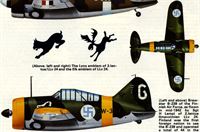Фотографии
-
Brewster F2A-2 of US Navy Squadron VF-2 in early 1941. The markings are in accordance with the BuAer instruction SR-2B of October 1940, with the lemon yellow tail indicating service aboard the USS Lexington (CV-2). Cowling and wing chevrons, also in lemon yellow, indicate the sixth three-aircraft section squadron
Самолёты на фотографии: Brewster F2A Buffalo / B-239 - США - 1937
-
Регистрационный номер: AN210 Buffalo I AN210, coded TD-J, as used by No 453 Squadron, RAAF, at Sembawang, Singapore Island, in November 1941. The finish was standard RAF, the aircraft having been part of the British order for 170 Brewster B-339Bs.
Самолёты на фотографии: Brewster F2A Buffalo / B-239 - США - 1937
-
This Brewster F2A-3 was operating with US Marine Corps Squadron VMF-221 at Ewa, Hawaii, in mid-1942. The non-specular blue-grey finish on upper surfaces had been introduced in October 1941, leaving undersurfaces non-specular light grey.
Самолёты на фотографии: Brewster F2A Buffalo / B-239 - США - 1937
-
In the aftermath of the Japanese onslaught on the Netherlands East Indies, a number of Dutch aircraft arrived in Australia - some from the NEI and others diverted en route from the US.
Самолёты на фотографии: Brewster F2A Buffalo / B-239 - США - 1937
-
Регистрационный номер: B-399 The standard finish of the ML-KNIL (Royal Netherlands Indies Army Air Corps) depicted on a Brewster B-339D in December 1941. B-399 was the fifth of the 72 fighters of this type for use in the NEI.
Самолёты на фотографии: Brewster F2A Buffalo / B-239 - США - 1937
-
Регистрационный номер: W8153 A diversity of markings is shown on this Buffalo I, which as WB153 was allocated to No 67 Squadron, RAF, at Kallang. It was passed on to No 21 Squadron, RAAF (hence the GA codes) and finally acquired Dutch markings before being captured by Japanese forces.
Самолёты на фотографии: Brewster F2A Buffalo / B-239 - США - 1937
-
Регистрационный номер: B-395 On 24 February 1942, the governor-general of the NEI decreed that all aircraft in the operational area should carry this marking - a representation of the Dutch flag - to avoid the earlier triangle marking being confused with the Japanese Hinomaru
Самолёты на фотографии: Brewster F2A Buffalo / B-239 - США - 1937
-
Регистрационный номер: BW-354 Brewster B-239 of the Finnish Air Force, as flown in mid-1942 by Sgt H Lampi of 2.lentue Ilmavoimien LLv 24. Finland was the first foreign nation to use the B-239 and operated a total of 44 in the Winter and Continuation Wars, with some success.
Самолёты на фотографии: Brewster F2A Buffalo / B-239 - США - 1937
Статьи







